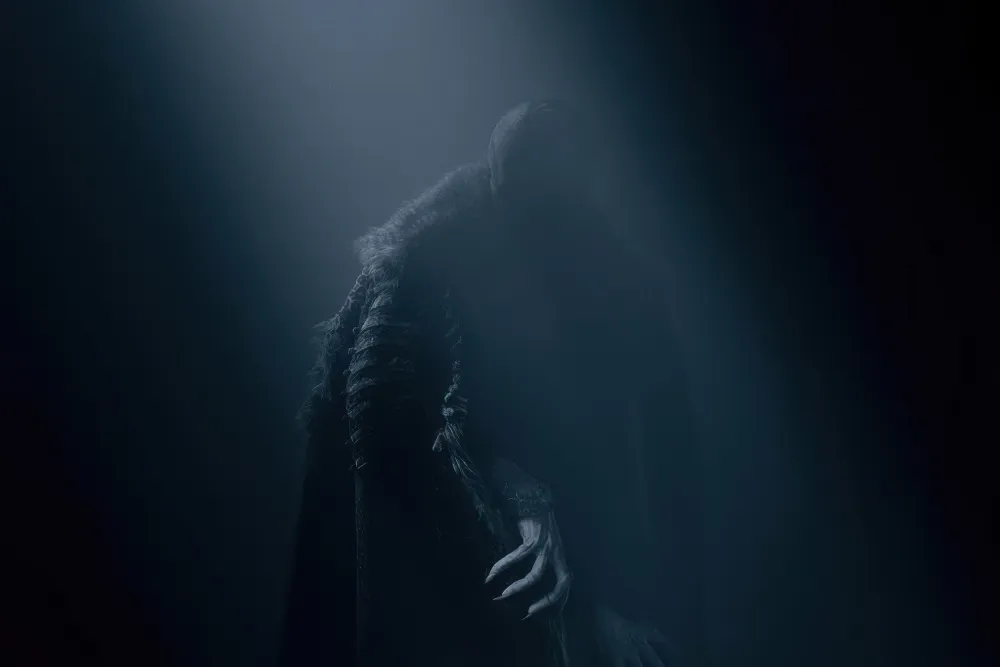This remake is loaded with gorgeous gothic imagery and a few squeamish delights, but its attempt to flesh out the narrative leads to some dreary results.
It’s certainly a tall order to remake one of the most influential horror films of all time- which is why it’s only been done once before in Werner Herzog’s Nosferatu the Vampyre. Yet, the maestro of the macabre Robert Eggers (The Lighthouse, The Witch) feels like the safest pair of hands to do this. After all, he has brought us some of the most striking, atmospheric, and “WTF” films of the last decade. Surely, he, more than anyone, could reimagine the film’s indelible legacy for today’s over-stimulated multiplex audiences. The answer to that is sort of, as while his Nosferatu is visually ravishing, it feels dead behind the eyes.
The film hews closely to its predecessor, as newlywed Thomas Hutter (Nicholas Hoult) is sent by his boss Knock (Simon McBurney) to the castle of Count Orlock (Bill Skarsgard) to finalise his purchase of a mansion in Hutter’s hometown of Wisborg, Germany. This dismays his new bride, Ellen (Lily-Rose Depp), who has once again started experiencing the nightmarish visions and ghoulish premonitions she suffered in her early life. However, Thomas ignores her warnings not to leave and deposits her with their close friends Friedrich and Anna Harding (Aaron Taylor Johnson & Emma Corin) before travelling to Transylvania. Unsurprisingly, Ellen’s fears are apt as Thomas is stalked and tormented by Orlok, in the usual bloodsucking Nosferatu/Dracula fashion, before the count turns his attention to Ellen and Wisborg, which he quite literally plagues with his presence.

Nobody could question Eggers’ reverence for Murnau’s original nor his commitment to creating a full-on vampiric feast of a film. Orlok is a ghoulish treat to gaze upon, transformed from a bolt-upright rat-man, first portrayed by Max Schreck, into a writhing parasitic succubus. Skarsgård also deserves plaudits for the intense physicality he brings to the role, although he does sometimes sound like a Russian lech trying to sell cologne. The cinematography courtesy of Jarin Blaschke is nifty and slinks between scenes seamlessly, while the production design from Craig Lathrop is impressively baroque.
Eggers also tackles some of the iconography and indelible scenes from the original with great aplomb. The scene where Thomas is first picked up by Nosferatu’s carriage, presented in the original using the negative film strip, is given a spectral and otherworldly tint that I struggle to adequately describe. Meanwhile, the film’s shadow play is a real treat, as it toys with the liminal space Nosferatu occupies and provides the film’s most evocative imagery. This includes one much-trailered shot of Nosferatu’s claw spreading over the town. This version is certainly not lacking in visual thrills, as every shot seems engineered to loom with dread and portent.
However, me thinks Nosferatu doth portent too much! Indeed, the characters themselves spend a lot of time telling us how ominous everything is, including Ellen, who quite literally tells us how her vision “Portents”. The problem is that under the surface of all this foreboding, the narrative itself feels frankly perfunctory. In adapting the story, Eggers has broadened it out, weaved the Hardings closer to it, and added a whole bunch of occultist exposition delivered by Willem Dafoe, who functions as our Van Helsing stand-in. This makes the film a bit more cohesive, but it also rationalises narrative and character within classical Victorian Gothic conventions. What results is a film robbed of the enigma and elusiveness which made the original so compelling, and which doesn’t compensate for this with any novel developments or insights.

In making the film more expositional, Eggers has also reframed it squarely around Ellen and her direct bond with Nosferatu. This has some interesting potential, but all Eggers does with this is to lean heavily into Victorian themes of lust and obsession with a heavy dose of general psycho-sexual drama. There is a laudable attempt to give Ellen more agency- which is fitting considering her crucial importance in the final act- but this largely falls flat. Depp certainly has the porcelain complexion and arresting beauty of an old-school ingenue, but sadly, she also has the dainty, fragile and unengaging persona of one as well. What’s worse, the attempts to liven her character are consigned to a lot of jerking (which sometimes works but sometimes feels silly) and a brief argument between her and Hutter, which ends in a pointless sex scene and isn’t explored further.
Depp should not be singled out for criticism, however, as a malady for grand annunciation seems to have infected the entire cast. Everyone sounds very posho and very English for a town in Germany. I know this issue troubles countless films, but there is something cartoonishly anglicised here, and the only character note Aaron Taylor-Johnson seems to have received while filming is to be more moustache-twirly.
This new Nosferatu is an admirable effort simmering over with the passion of its director. However, that director also doesn’t have anything new to add to the story, leaving the film a beautiful dud.

